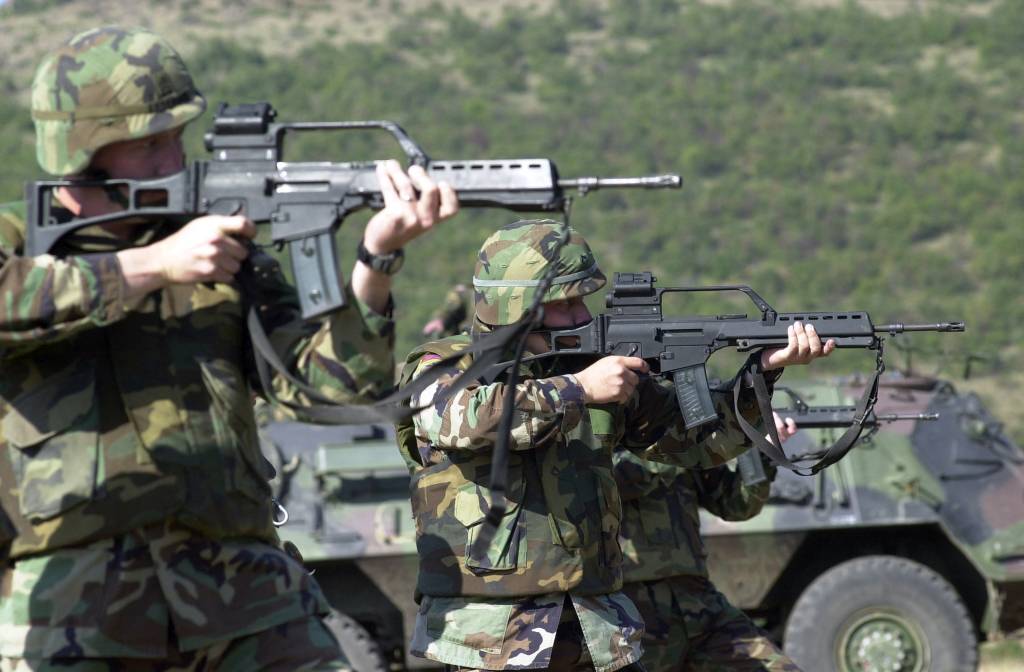Is it the plastic barrel holder? Or the tin cover? These questions are at the center of a hot debate surrounding “serious faults” with the Bundeswehr’s favorite gun. DW leads you through the storm that is the HK G36.
It all started back in 2010, on Good Friday, following a Taliban ambush just outside German ISAF headquarters in Kunduz, northern Afghanistan. Thirty-two Bundeswehr paratroopers, cut off from the rest of their division, were plunged in a completely unexpected, nine-hour struggle of life and death.
During the firefight, the rifles being used by the paratroopers overheated, forcing them to retreat, and on the way back to Kunduz, an armored vehicle that had been dispatched rode over a landmine. The April 2, 2010 attack cost the lives of three German soldiers, and it initiated a debate that reached its climax this Wednesday, over five years later, concerning the Heckler & Koch G36 assault rifle.
The lightweight assault rifle is used daily around the world, from Spain to Brazil and Indonesia, and has been part of operations that include the British SAS in Iraq and everyday security at the San Francisco Police Department, to name only a few. For almost two decades now, it has been the standard infantry service weapon of the German military; and all this time, it has had “serious faults,” the federal defense minister, Ursula von der Leyen, has now confirmed.
The accuracy degradation can reach 0.5 meters at a range of 200 meters, and 6 meters at a range of 500 meters
Cherry-hot barrel
When the G36 overheats, either because of the temperature it finds itself in or because of constant, rapid fire, the precision and accuracy of the rifle suffer. The reason for this, according to the Defense Ministry, is that the rifle’s barrel holder is made of a composite polymer that – even at a temperature as low as 23 degrees Celsius – softens and is no longer able to hold the barrel straight. Many of the components of the rifle are made of plastic, which account for its lighter weight when compared to its counterparts, such as the French FAMAS or the American Colt AR-15.
A strictly classified series of tests conducted over the past months by three different applied science organizations, two Bundeswehr-related and one independent, was presented to von der Leyen at the end of March. The results, which were leaked to Reuters and select German media outlets, raised eyebrows well beyond the Defense Ministry.
All it takes is two magazines (60 rounds of ammunition) to heat up the barrel to an extent that “serious accuracy degradation” occurs, the researchers found. At this point, the accuracy degradation can be as severe as 50 centimeters at a range of 200 meters, and a full 6 meters at a range of 500 meters.
“The Heckler & Koch G36 has no future in the German army in its current state of construction,” von der Leyen said in front of dozens of journalists following a special convention of the parliamentary committee on Wednesday.
‘Wrong, irrelevant and possibly illegal’
Heckler & Koch, meanwhile, which wasn’t involved in the tests, has its own ideas about why they produced the results they did; the company vehemently rejects all claims that the plastic barrel holder was responsible for any accuracy degradation, blaming the overheating on the tin protective covering applied to the barrel by the Bundeswehr before use in the field.
“H&K views any negative statements with regard to the accuracy [of the G36] as factually incorrect, irrelevant and possibly illegal,” says a statement from Germany’s largest firearm supplier, which has played a substantial role in making the Federal Republic the world’s third largest weapons exporter.
“Decades of use by the Bundeswehr validate that the G36 was – and continues to be – fully operational,” the statement continues.
H&K refers in its statement to the fact that the G36 was designed for use back in 1996, and that the Bundeswehr checks each individual shipment of the assault rifle before clearing them for use in training and combat. At present, there is a contingent of 167,000 G36 rifles in the Bundeswehr arsenal, used for years in “myriad different operational environments.”
Convertible or minivan?
Those differing “operational environments” are precisely the problem when it comes to the G36, not the rifle itself, say defense and weapons commentators in and outside of Germany.
“There is absolutely nothing wrong with this rifle,” said Heinz Schulte, former Jane’s Defence Weekly correspondent who now oversees the Griephan international security publication, in an interview with DW.
“The debate going on right now about the ‘technical faults’ of the G36 is frightfully misinformed,” said Schulte, with reference to the fact that the assault rifle was designed, constructed and sold to the Bundeswehr at a time when soldiers engaging in suspended firefights was inconceivable.
“This is comparable to a young man who, as a bachelor, bought a two-seater convertible and now complains that he has a family and they don’t all fit into that car!”
Schulte was also skeptical that the G36 would be completely phased out, arguing that a more sensible option would be to update the assault rifle and keep it for operations in which suspended fire is highly unlikely.
“If you fire a machine gun, anybody with any technological sense knows that the barrel has to be changed because the friction of rapid fire makes it too hot. With an assault rifle like the G36, you can’t change the barrel, so making a gun like this the standard issue for all military scenarios is simply old thinking.”
Will the German army jump to a different company for its new rifle? No, said Schulte, explaining there will most likely be a mix of different guns that do justice to the many scenarios in which Bundeswehr soldiers currently find themselves in.
For paratroopers such as those who got caught in the Good Friday ambush in 2010, there will most likely be two options, both Heckler & Koch, said Schulte:
“For situations where intensive fire is needed, it will either be the HK 416 or HK 417, depending on the caliber needed.”











